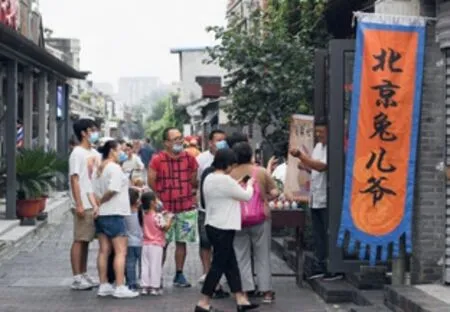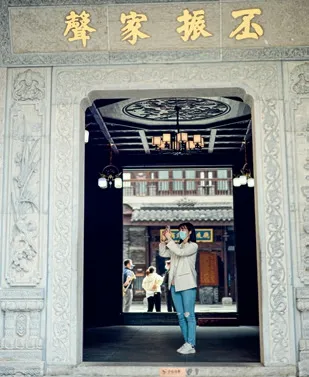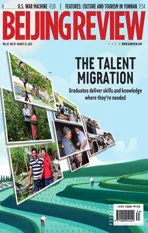Discovering Worlds Within Neighborhoods
2022-08-24WalkingtoursbecomebuzzworthytraveltrendinmanyChinesecitiesByZhangShasha
Walking tours become a buzzworthy travel trend in many Chinese cities By Zhang Shasha
For many people, the concept of travel has always gone hand in hand with distance.A holiday hasn’t been a holiday without a plane, train or at least a bus ticket, and new discoveries have only been sought in exotic destinations. However, the emergence of COVID-19 and its related travel restrictions have redefined travel in China, leading many to make profound discoveries in their own neighborhoods and even right outside their own front doors.
Cai Yitong loves to travel to distant places. The 30-year-old has seen lions running on the African grasslands, experienced Mediterranean culture and photographed aurora borealis. However, nowadays she indulges herself with threading through thes in Beijing, where she has lived for almost 12 years for study and work.
“I thought I was familiar enough with the city.Too familiar to consider it a travel destination, even though I knew there was still much to be tapped in it,” Cai told. “...until the pandemic prevented me from leaving the city.”
s are traditional narrow alleyways made up of rows of courtyard houses, which exist in the old part of Beijing and some other northern Chinese cities.Inneighborhoods, Cai discovered the “trick”locals use to park in the narrow alleys, learned they cannot break their afternoon gossip conventions “unless their houses are on fire” and heard the distinctive stories behind the names of every singleshe passed through. More importantly, she began to appreciate the value of the culture on her doorstep. “These are as equally thrilling as enjoying the northern lights and the lions running far away,” Cai said.
Since the outbreak of the pandemic, the number of city ramblers like Cai has been increasing in many Chinese cities. They often take a 6 to 8-km walking route, observing the historical, architectural and cultural urban surroundings that are less known, even among locals. The walking tours are either self-guided or in small groups under the guidance of artists, historians or architects, which highlights in-depth experience instead of surface-level knowledge.
A new exploration of cities
The pandemic slowed down Cai’s pace of life. But the innately curious woman could not stay indoors for long. She began strolling around local neighborhoods and her city walk plan began only by chance.
One day she went to visit Xizongbu Hutong, a tourist hit in Dongcheng District, where traditionals and the iconic CITIC Tower can be shot in one picture. She didn’t linger there for too long before wandering into anamed Lumicang, which means a storehouse for the grain that was used for officials’ salaries.
The name aroused her interest and she discovered online that, in the Ming(1368-1644) and Qing dynasties (1644-1911), it was, as the name suggests, a place to store grain for officials. The experience inspired Cai to explore the stories behind the names of Beijing’ss.
Later on, Cai visited manys, either well-known or little-known, including the Baihua Shenchu Hutong, or the Hundred Flowers Hidden Depths. It is said that in the Ming Dynasty (1368-1644), a couple planted a garden here, which attracted group after group of literati, thus it received its beautiful name. In modern times, it became well-known again as the location of one of the earliest studios in the golden age of Chinese rock music in the early 1990s.

Tourists in a hutong in downtown Beijing on August 27, 2020

A tourist takes photos in an ancient building in Chongqing on April 13
Cai designed some-themed walking routes after visiting many of them in person and shared the routes with her friends. She has been called a walking travel encyclopedia among friends for traveling through many places, pioneering the trend of traveling alone in her 20s and, this time, the first promoter of city walks.
“With 40 years of development, China’s tourism industry has entered a new phase,” Dai Bin, head of the China Tourism Academy, told the. “Travel is no longer restricted to scenic spots and shopping centers but is also possible in people’s living spaces.”
A flash in the pan?
Unlike Cai who offers customized walking options only to friends, Lei Yuanwei has turned his hobby into a career.
Being a tour guide in European countries for 15 years, Lei suffered a great loss due to the slumping demand for outbound tourism with the impact of the pandemic.However new opportunities emerged as city walks are on the rise in Chengdu, capital of Sichuan Province where he resides. Lei made full use of his expertise and seized the opportunity.
Tracing back the old city life, experiencing local tea culture, learning about the dozens of special Sichuan condiments and trying the intangible cultural heritage of“ear cleaning”… the distinctive varieties of themed tours went viral on social media, bringing him many customers, most of whom were young people.
The local authorities invited Lei to participate in a government-led community program, aiming to enrich cultural scenarios for residents in Shaocheng, aka the old town in the western part of Chengdu. Lei designed routes linking local cultural heritage sites and the experience inspired him to combine city walks with public service activities.
Other regions have also aspired to make use of their cultural and historical resources and launched city walk programs.
In Beijing, the Dongcheng District Government proposed the Heart of Beijing program in partnership with professionals including crafts people, food critics and scholars, as well as companies such as Caissa.com,a tourism platform. The first 22 themed routes cover tourist attractions such as the Central Axis of Beijing and the Palace Museum.
is a knock-out product of a program launched by the Shanghai Dramatic Arts Center. Audiences were an integral part of the immersive outdoor dramashow, walking 1.3 km in two hours together with the performers, from the former residence of Madame Soong Ching Ling, a prominent member of the leadership in the early decades of the People’s Republic of China, to the center, to recall and experience every detail of the wartime events that took place on this road in downtown Shanghai through live performance. The program made the city a stage for all participants.
Currently, city walks are growing rapidly in large Chinese cities, becoming not just an option for tourists, but also a fashionable leisure activity for locals.In addition to walking, cycling, photo-shooting, and immersive performances are all featuring on the tours,with more innovations expected.
Dai said more and more tourists will get involved in exploring the cities they live in, creating a big market for providers of related products and services. Travel agencies, both offline and online, need to develop distinctive routes to attract the potential city ramblers.Online platforms like Dianping, Xiaohongshu and Douyin, where many young adults share trendy lifestyles, will also play an important role in promoting the tours to a broader audience, he added. BR
